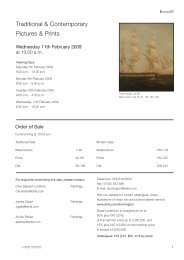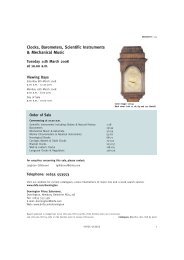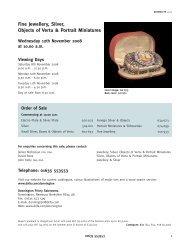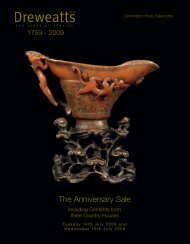Donnington Priory Salerooms
Donnington Priory Salerooms
Donnington Priory Salerooms
Create successful ePaper yourself
Turn your PDF publications into a flip-book with our unique Google optimized e-Paper software.
18<br />
A Regency mahogany bowfronted<br />
cistern tube stick barometer<br />
Barrauds, London, early 19th<br />
century<br />
With cavetto moulded caddy upstand<br />
above glazed rectangular silvered<br />
vernier register, annotated and<br />
calibrated in inches, with mercury<br />
Fahrenheit thermometer and signed<br />
Barrauds, LONDON to upper right<br />
corner, the trunk with ivory vernier<br />
adjustment disc and ebony line inset<br />
edges above ebonised urn-shaped<br />
cistern cover to the rectangular base<br />
with ebony line inlaid canted angles and<br />
cavetto moulded underside, 99cm high.<br />
Paul Philip Barraud is recorded in Baillie<br />
G.H Watchmakers & Clockmakers of<br />
the World as working 1796-1820, he, in<br />
partnership with W. Howells and<br />
G. Jamison, was charged with making<br />
Mudge’s marine timekeepers. The firm<br />
was continued by his sons becoming<br />
Barraud and Lund in 1839.<br />
£2,500-3,500<br />
19<br />
A George III parquetry strung<br />
mahogany bulb cistern tube stick<br />
barometer<br />
Keate, circa 1810<br />
With broken pediment above shaped<br />
engraved brass scale with vernier,<br />
alcohol tube Fahrenheit thermometer<br />
and signed KEATE, FECIT to upper<br />
margin, above caddy edge-moulded<br />
trunk with exposed tube flanked by<br />
angled-grain veneers and parquetry<br />
strung borders, with domed cistern<br />
cover to the rounded base,<br />
97cm high<br />
£200-250<br />
10<br />
20<br />
A rare Queen Anne walnut<br />
cistern tube stick barometer with<br />
Royal Society scale thermometer<br />
In the manner of John Patrick,<br />
London,<br />
Unsigned, circa 1710 and later<br />
The ogee caddy top pediment with<br />
three turned brass finials above<br />
cavetto moulded break-arch cornice<br />
and arched herringbone border and<br />
foliate scroll engraved silvered scales<br />
with brass setting pointer and<br />
annotated for summer and winter<br />
conditions and inscribed Fair if Rise<br />
and Foul if Fall, flanked by pilasters<br />
with brass capitals and bases above<br />
cavetto moulded throat moulding, the<br />
trunk applied with alcohol<br />
thermometer with (replaced) silvered<br />
scale calibrated from 5 at the top<br />
down to 95 and with annotations<br />
from Extream Cold to Extream Hott<br />
flanked by vertical cross-grain cavetto<br />
mouldings to sides and with half<br />
dome above waisted cylinder turned<br />
cistern cover also enclosing<br />
thermometer bulb and with gilt brass<br />
pendant finial to base (some<br />
restoration, thermometer scale<br />
replaced), 105cm high.<br />
A closely related example is illustrated<br />
and described in Claxton Stevens,<br />
Christopher and Wittington, Stewart<br />
18th CENTURY ENGLISH<br />
FURNITURE, THE NORMAN ADAMS<br />
COLLECTION, page 463. The Royal<br />
Society scale thermometer was<br />
devised by Robert Hooke in 1664<br />
and was calibrated to every degree<br />
representing an increase of 1/500 in<br />
volume of the thermometer liquid.<br />
The scale used the freezing point of<br />
water as the fixed point and was<br />
scaled from high to low with the<br />
increase of temperature. As the rate<br />
of expansion of the alcohol varied<br />
between instruments, each scale had<br />
to be individually made<br />
for the instrument. The current Lot<br />
has a replacement silvered scale as<br />
the original paper scale had probably<br />
become to worn and discoloured to<br />
read. Hooke’s original thermometer<br />
was adopted and became known as<br />
the standard of Gresham College and<br />
used by the Royal Society until 1709.<br />
£2,500-3,500<br />
21<br />
A William and Mary style<br />
olivewood cistern tube stick<br />
barometer in the manner of<br />
John Patrick<br />
Unsigned, circa 1695 and later<br />
The superstructure with arched<br />
pediment, brass ball finials and<br />
swollen frieze above fretwork upright<br />
flanked by ebonised twist turned<br />
columns, the later silvered<br />
herringbone border and foliate<br />
engraved two-part break-arch scale<br />
with brass setting pointer above<br />
replaced exposed bulb-cistern tube<br />
flanked by cross-grain veneers and<br />
ebonised caddy moulded edge<br />
above fretwork flared side panels and<br />
later half-round ring-turned cistern<br />
cover with ogee moulded underside,<br />
(restorations and replacements)<br />
120cm high.<br />
The decorative ‘hood’ superstructure<br />
which incorporates spiral twist<br />
columns emulates the design of<br />
longcase clock from the end of the<br />
17th century and bears similarities to<br />
examples depicted in John Patrick’s<br />
advertisement of circa 1710<br />
reproduced in Goodison, Nicholas<br />
English BAROMETERS 1680-1860<br />
page 48. Although this configuration<br />
appeared to be popular well into the<br />
first two decades of the 18th century,<br />
Edwin Banfield suggests<br />
(BAROMETERS Stick or Cistern Tube<br />
page 18) that the use of fretwork<br />
in the case indicates a date prior<br />
to 1700.<br />
£1,500-2,500<br />
www.dnfa.com/donnington






